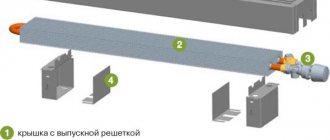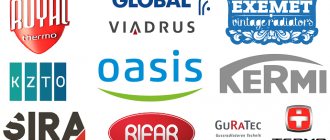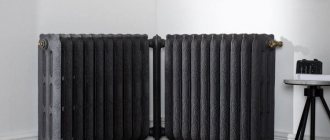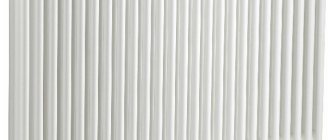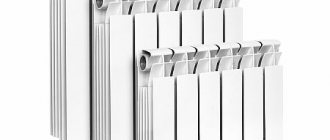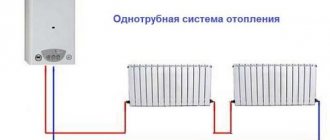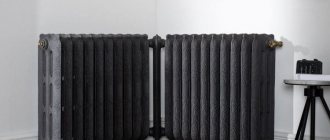In-floor convectors are heating devices that operate on the principle of air convection. They are built into the floor, usually under panoramic windows, and quickly heat the air, which rises as the temperature rises. This way, the room is heated more evenly than when heating the heating element itself. In-floor convectors have increased heat transfer, they are aesthetically pleasing and reliable. Their main advantage is invisibility. They are recessed into the floor; on the outside there is only a decorative grille, which is easy to fit into the design of any room. Convectors of this type are varied in technical characteristics. Before choosing an in-floor heating convector, you need to determine the conditions in which it will be used, and also understand whether this heating method is really needed.
What functions do convectors perform?
Due to the rapid popularity of these systems, you need to study all the existing functions of convectors to fully ensure that this system is suitable for heating your house or apartment.
Among the main functions of convectors are:
- Heating functions. The convector is designed to create heat in rooms. At the same time, this heating will not dry out the air.
- Prevention of fungi and dampness. This option exists if the system was installed near a window.
- Underfloor heating. This function allows the consumer to install the system on the floor, which will not take up much space and will look more aesthetically pleasing than conventional heating radiators.
Floor heating convectors that are built into the floor will look great in rooms designed in a minimalist style.
Basic requirements for the device housing
The appearance of the metal case does not play an important role, since it is located in the floor of the room. Particular attention should be paid to the quality of this element, since the reliability and durability of the heating unit depends on the indicator and its class is determined.
The metal from which the body is made plays an important role:
- For installation in damp rooms, a convector with a body made of stainless material with increased moisture resistance is suitable.
- For dry rooms, select a device with a body made of galvanized or black steel, which is coated with anti-corrosion paint, resistant to external influences.
Typically, special powder compositions are used to coat the metal body. They effectively protect metal from rust formation and external influences.
Designers recommend choosing convectors whose parts and inner walls of the housing are painted in a dark color. They are almost invisible, so they look more aesthetically pleasing
Types of heating convectors
In the heating systems market, manufacturers from year to year try to diversify their range with new models of convectors, which differ in functionality, size and operating principle.
The most popular are:
- Convectors that provide for natural convection, that is, natural circulation of the air mass. Devices of this type carry out heating using heat exchangers, with the help of which there is a gradual natural movement of the air mass to the upper zone of the premises. This operating principle ensures gradual heating of the entire area of the room.
- Convectors with a fan. A distinctive feature of this device is the forced circulation of the air mass using a special fan. At the moment, this is the most popular convector system, because it provides complete heating of the room in a very short time (from ten to fifteen minutes). At the same time, the disadvantage of such a convector is the dust that the fans raise.
At the same time, there are a couple more types of convectors:
- Built-in water convectors in the floor. From the name you can understand that heating occurs using water. In order to withstand heat, the grilles of such convectors are made of heat-resistant materials. It is worth noting that the installation of this system is very complex and resource-intensive. This system is attractive because the cost of maintaining such a system is much lower than that of electrical systems. In general, the advantages of this system include unique compatibility with any floor, cost-effectiveness and efficiency, the ability to use such a system as the only source of heating in a house or apartment, and does not create dryness in the air. Among the disadvantages of this system are the complexity of the installation process and the need for specialist help, because installation work can really cause difficulties.
- Built-in electric convectors in the floor. This system operates on tubular electric heaters; the only condition for installing this convector is free access to electricity, that is, accessibility to electrical networks. In general, this system is much easier to install than water convectors, but is more expensive.
Dependence of price on heater characteristics
The cost of the convector will consist of its following characteristics:
- The pressure used and the heating temperature given;
- Total thermal power;
- Fan noise;
- Their number in the design;
- Average energy consumption;
- Availability of size chart;
- Features of decoration.
Selecting a heater with specific characteristics and so that they correspond to price/quality indicators is not so difficult today - fortunately, most convector models are sold according to the so-called “designer” scheme (the entire device is equipped with the corresponding elements separately).
Regarding prices, we can talk about the rather high cost of the equipment in question in general. For example, even for a brand released in the vast countries of the former USSR, you will have to pay about 16,000 rubles for a sample with a power of 1000 W. In the former republics, production is mainly focused on models for heating a total area of up to 25 meters with a total price of 50,000 rubles.
How to choose the right convector
To clearly understand what a convector is and what parameters to pay attention to, you need to study the list of technical characteristics that are important:
- Power indicators. One of the most important parameters in a convector, because the higher this indicator, the more efficient the heating of the room will be.
- Dimensions. You should pay attention to this indicator if you have already prepared a special in-floor niche for the device. Also pay attention to the size of the room itself.
- Compliance with quality standards. When purchasing a convector, you should pay attention to whether it has the appropriate documents that confirm the device’s compliance with state quality standards.
Crimping pressure indicators. This indicator must correspond to the pressure of the central heating system.
General tips for installing a convector after installing the final flooring
Such situations may arise during construction work; the installation location of the convector should be provided during the installation of the flooring and heating system. The dimensions of the recess must correspond to the dimensions of the housing with a margin of 2–3 cm around the perimeter; the length of the plastic pipe outlet must guarantee trouble-free connection of the device. They are always made with a reserve, the excess length is then cut off.
Installation diagram of convectors, indicating the dimensions of the niche for equipment
Niche for in-floor convector
It is recommended to install the convector at a distance of no more than 30 cm from the window, otherwise the double-glazed windows may fog up - warm air will not heat their surface. The thickness of the thermal insulation layer under the convector body should be adapted to the overall height of the finishing coating; it is advisable to use the same thermal insulators as under the main floor surface.
It is recommended to install the convector at a distance of no more than 30 cm from the window or door
Most convectors have a right-hand standard connection, but you can change it yourself or, at the time of purchase, select the type that matches the existing wiring. Place the fans in the housing on the side of the window or doorway; they should capture cold air. Due to this placement, the efficiency of the device increases and the microclimate in the room improves.
It is imperative to connect the Mayevsky tap to the heat exchanger; it is located at the coolant inlet. The Mayevsky tap allows you to vent the convector; failure to perform this operation may cause the device to malfunction.
Mayevsky crane
The power connection is carried out according to the diagram, and the fan rotation speed can be changed with a potentiometer. After completing the electrical installation, all open connections must be covered with special sealed covers. Make sure that the rubber gaskets do not have mechanical damage. Mount the controller to the wall at a height of approximately 1.5 m from the floor, this position is convenient for use.
Popular convector manufacturers
When purchasing such a device, you need to understand that not every brand is of high quality and safety. Before purchasing, check out the list of the most popular brands.
Among them are:
- Danish manufacturer Devi, which provides a twenty-year guarantee on its products. Systems from this manufacturer are distinguished by high strength, wear resistance and fairly low prices. This brand produces convectors of different types, with different parameters.
- Finnish manufacturer Ensto. This company has been operating since the mid-twentieth century. During this time, this manufacturer has become the largest in the production of heating systems. A distinctive feature of this brand is its full compliance with quality standards, as well as the environmental friendliness of its products.
- English manufacturer Energy. A relatively new company on the market, which has already become one of the best manufacturers of heating systems. These systems are very popular among domestic consumers, since their prices are quite low and the quality is high.
- German manufacturer Rehau. This company was formed back in the twentieth century, during which time the manufacturer managed to surprise consumers with its innovative solutions and quality.
- German manufacturer Kermi. This brand produces high-quality products that become better and better year after year. This manufacturer produces different types of convectors, with different approaches to the device.
Advantages and disadvantages of convectors
When deciding whether to purchase such a device or not, you need to carefully study all its advantages and disadvantages.
The advantages of this device include:
- High power levels.
- Quite a simple installation and setup process.
- Multifunctionality of the device.
- Compliance with all quality and safety standards.
- Huge selection of device designs.
- The ability to retain heat in rooms for a long time.
Among the disadvantages are:
- Not all devices will be able to provide enough heat to be the only, main source of heating in the room.
- Creation of dust and mud flows, which necessitates regular and frequent cleaning.
The need to call a specialist for high-quality installation and configuration.

